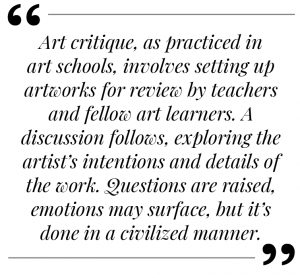 Certainly, we artists encounter critiques of our artistic endeavors. Some of it is helpful, providing constructive feedback, while some can be discouraging, questioning our artistic abilities. This is especially true when sharing our artworks online, where trolls and bashers may attack without understanding art. However, it’s essential to recognize that this is part of being an artist.
Certainly, we artists encounter critiques of our artistic endeavors. Some of it is helpful, providing constructive feedback, while some can be discouraging, questioning our artistic abilities. This is especially true when sharing our artworks online, where trolls and bashers may attack without understanding art. However, it’s essential to recognize that this is part of being an artist.
But what exactly is art criticism or critique? It’s not just expressing opinions or judgments based on personal preferences. Art critique, as practiced in art schools, involves setting up artworks for review by teachers and fellow art learners. A discussion follows, exploring the artist’s intentions and details of the work. Questions are raised, emotions may surface, but it’s done in a civilized manner.
Why is art critique necessary? It’s not about changing an artist’s work or offering unsolicited opinions. Art is meant to be free, reflecting the artist’s ideas. If your opinion is accepted, great; if not, respect their choice. Critiquing is more beneficial for the critic, helping them learn and develop their understanding of art.
Here are some tips for constructive art critique that I derived from various sources:
Observe Carefully: Spend time looking closely at the artwork. Did the artist apply artistic elements and principles? If not, why? Understand the choice of materials, colors, etc.
Originality: Assess the originality of the artwork. What influenced or inspired it?
Understand the Idea: Why did the artist create this piece? What is the underlying idea or message? Be empathetic, recognizing that sometimes the concept may outweigh the execution or vice versa.
Appreciate the Positive: Instead of just finding faults, also appreciate what makes the artwork wonderful.
Ask Questions: If you’re unsure, ask questions rather than making declarative statements. Avoid pretending to be all-knowing; you don’t have to label art as good or bad.
Be Mindful of Statements: Avoid making provocative statements that might sound harsh. Remember, you’re not alone in the room, and your words can have an impact.
Many artists, especially young ones, may avoid art communities or exposing their artworks due to fear of critique. However, embracing the possibility of positive outcomes can be beneficial. It’s challenging to gain a good perspective on your work alone, so opening it to others for assessment provides valuable insights. Let go of biases, and you’ll learn and gain substantial growth in your art.


